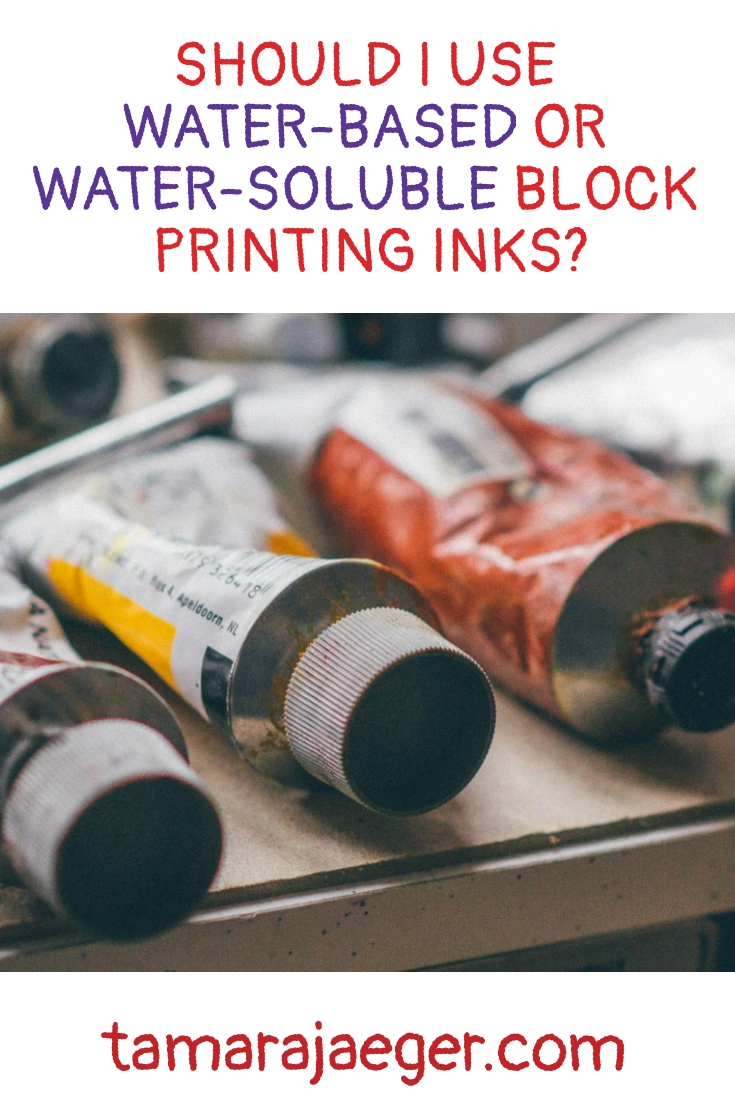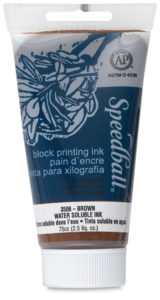Posts Tagged: linoleum block printing ink


Should I Use Water-based or Water-soluble Block Printing Inks?
While I don’t do it that often, I enjoy making linocuts. Well, I actually really enjoy carving the plates. Printing by hand, not so much. I think if I’m going to be doing them regularly or frequently, it might just be worth investing in a small press for printing them.
In the meantime, I’m going to try out an actual baren for printing, rather than the old wooden spoon I have been using. Hopefully that will make it easier to make the prints. It can be difficult to get good, even pressure over the entire print using the (curved) back of a spoon. I also find it tiring on my wrists and hands.
The other change I’ve made since the last time I made linocut prints is that I tried out a new printing ink. Traditional oil-based printing inks need to be cleaned up with solvents and I’m Super sensitive to mineral spirits. So I had been using Speedball’s water-based block printing inks. What I like about them is that they’re non-toxic, clean up (easily!) with water, are available in a good range of colors, and most colors have good to excellent lightfastness. They’re also inexpensive and readily available in most art and craft stores.
Speedball Water-Based Block Printing Inks

The issue I have with the Speedball Water-Based block printing inks is that their working properties aren’t as good as oil-based inks. They dry too quickly, especially in warm weather or in the winter when the indoor humidity is low. This makes it difficult to print the image evenly, since you have to work Very quickly. I’ve often only managed to get a couple good prints at a time, with many more that are poor quality—patchy or with faded areas. I do still use my Speedball inks
for making proof prints, since they’re faster and easier to clean up and less expensive, so I don’t feel like I’m wasting the “good” ink.
Caligo Safe Wash Relief Ink

The ink I’m currently trying out is Caligo Safe Wash Relief Ink . And so far, I LOVE it. So far I’ve only tested out the black, but it handles much better than the water-based inks I had been using. And there’s a reason for that— Caligo Safe Wash
is actually an oil-based ink. The beauty of this ink, however, is that it can be cleaned up with soap and water—no solvents needed! Much like the newer, water-mixable oil paints (which I also love), Caligo Safe Wash
is made with a modified oil that can be cleaned up with soap and water. Due to the oil base, it has a longer working time, so I find that it prints evenly, without the pale areas or patchiness I often get with water-based inks. The black color is rich and deep. I’m definitely planning on getting a few more colors to try out. On a side note—I also have a couple tubes of a different brand of water-based ink, Schmincke Aqua Linoprint Ink
, that I haven’t yet had a chance to test out. I’ll be sure to update you on how that brand works once I’ve had a chance to try it!
But back to the Caligo Safe Wash ink. Drawbacks are the price—it’s not cheap. But then, high-quality artist’s materials never are. It also is not nearly as easy to clean up as a water-based ink. Yes, soap and water takes it off, but you have to be careful how you do it and when you introduce the water. The manufacturer’s instructions say to apply liquid soap to the inky surfaces and work it in well with a brush first and Then rinse it off with water. Water alone can cause the ink to stick and become non-water-soluble. I washed my blocks and tools off in the bathtub, since my sink is pretty small (tiny!), and it makes quite a mess! I find that it leaves a grey ink residue in the bottom of my tub that needs some extra cleaning to remove.
Overall, I really like the Caligo Safe Wash Relief Ink . It handles like an oil-based ink, because it Is an oil-based ink, but it can be cleaned up without any harsh or toxic solvents. I will definitely continue to use this ink and will try out more of the colors in the product line. The Speedball’s water-based block printing inks
shouldn’t be overlooked, however. They can certainly be an appropriate choice, depending on the circumstances. They are non-toxic and very easy to clean up and would be a great option for children or group classes.
Have you tried water-based or water-soluble printing inks? What did you think? What brands do you use and why?
Want to keep updated and see more of what I’m working on? Sign up for my mailing list here and get a totally FREE digital download of a tiger linocut print. (I promise not to be spammy with my emails—I hate that too!)
* Please note that this post contains affiliate links and any sales made through such links will reward me a small commission – at no extra cost for you.